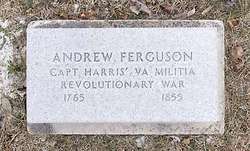Welcome to another Grave Spotlight of the Month. February is Black History Month, so I thought that I would spotlight Andrew Ferguson this month.
Andrew Ferguson was born on in July of 1765 (though this could have been 1760) in Dinwiddie County, Virginia as a child of free black parents. He was the son of Andrew Peeleg Ferguson and an unnamed mother. It is not known if he had an siblings, though it is assumed that he did. As you can see, there is a discrepancy with his birthdate, this is because the Sons of the American Revolution chapter in Bedford, Indiana decided that his birth year was 1765. Now, it is also odd that this chapter of the SAR also decided that he was buried in Bedford, Indiana. There is no information for him being buried in Bedford anywhere that I have found.
Andrew served with his father in the Revolutionary War, noting in his pension application that they were both taken prisoners by the British and whipped with a "cat o'nine tail" and attempted to be pressed into service for the British.
Father and son managed to escape British capture and joined the American soldiers, willing to serve in the fight against the British, though other places note that he was drafted into the Continental Army. Whichever it was, Andrew served as a private in the Continental Army for over five years under General Green and later under Captain Harris, both for the Virginia Colony.
He fought many battles between 1780 and 1781 including those at Brandywine, Kings Mountain and Cowpens, being wounded a number of times, though the worst wound was one to the head while fighting against Lord Cornwallis' troops at the Battle of Guilford Courthouse in North Carolina. Due to this wound, a silver plate, reportedly made from hammered silver coins, was placed in his head which required several months of recuperation and finally discharge, in which is returned home to Virginia in 1781. Records are somewhat confusing here because he is also listed as having fought in the Siege of Ninety Six and Battle of Eutaw Springs, though both of these were in mid 1781, it is likely that he fought in these battles and then was discharged.
Between this time and census records dated between 1820 and 1830, his life his just bits and pieces He worked for a while in North Carolina, briefly returned to Virginia and then moved to Southern Indiana. He settled in Vincennes before moving to Bloomington. He shows up around this time in Bloomington, Indiana. The editor of the Bloomington Courier, a local newspaper, described him a "greatly liked". To keep himself occupied, he performed odd jobs around the town.
While in Vincennes, he applied for his pension but was denied because he was a black man. In August 1838, he applied for pension for his service again while working odd jobs around the town.
On August 20, 1844, he married Jane "Jenny" Murphy and they lived together in a log cabin on what is now South Lincoln Street. As you can see in the marriage records, both of their last names are spelled differently. It was said that they could not legally be married, assumedly because they were black, so their marriage was witnessed by and signed by John M. Young and IU Mathematics professor John M. Harney. They agreed to live together and that when he passed, his property would pass to her. I find this information interesting as they clearly were listed in the marriage records of the county.
On January 8, 1851, he applied for bounty land at the age of 96 years old. This was denied, so he applied again in 1855. In May of 1856, he was granted 160 acres of land. Unfortunately, Andrew Ferguson had passed away on October 1, 1855. Note that the ages and dates make his age at the time of death as 90 years.
His wife had died a week prior to his death and there were no children. A letter was sent along with the refused land grant certificate explaining his demise as well as that of his wife and children. It is also noted that Mr. Ferguson and his wife were living as paupers at the expense of the county.
Andrew's name is noted on a monument at the Battle of Kings Mountain as "The other Ferguson", so he would not be confused with Major Patrick Ferguson.
For many years, his grave went unmarked in Rose Hill Cemetery. In 1984, the Daughters of the American Revolution placed a marker in the Old Spencer Addition for him. There is no burial information for his wife Jenny. It is possible that she is buried near him in the Old Spencer Addition, but as there are no records for her burial, this is just a guess.
Rest In Peace, Andrew Ferguson.
~~~~
The Bloomington Herald Times February 1, 2008 and February 15, 2023
Daughters of American Revolution - Honoring Our Patriots Andrew Ferguson
The Times-Mail, Bedford, Indiana March 11, 2018
South Carolina 250 - Andrew Ferguson
American Revolutionary Museum - Andrew Ferguson
National Park Service - African American Patriots at the Siege of Ninety Six
Gaston Gazette - The Other Ferguson at the Battle of Kings Mountain
Revolutionary War Pension records - Andrew Ferguson
Reporter Times March 11, 2018
Indiana Historical Society - Early Black Settlements







0 comments:
Post a Comment